World Religions in Practice: Precepts of Buddhism, Zen Buddhism, Pure Land Buddhism, and More
VerifiedAdded on 2023/06/10
|6
|1905
|186
AI Summary
This essay explores the precepts of Buddhism, including dharma, Nirvana, socially engaged roles, and the role of women in the religion. It also delves into the emergence of new sects of Buddhism, such as Zen Buddhism and Pure Land Buddhism.
Contribute Materials
Your contribution can guide someone’s learning journey. Share your
documents today.
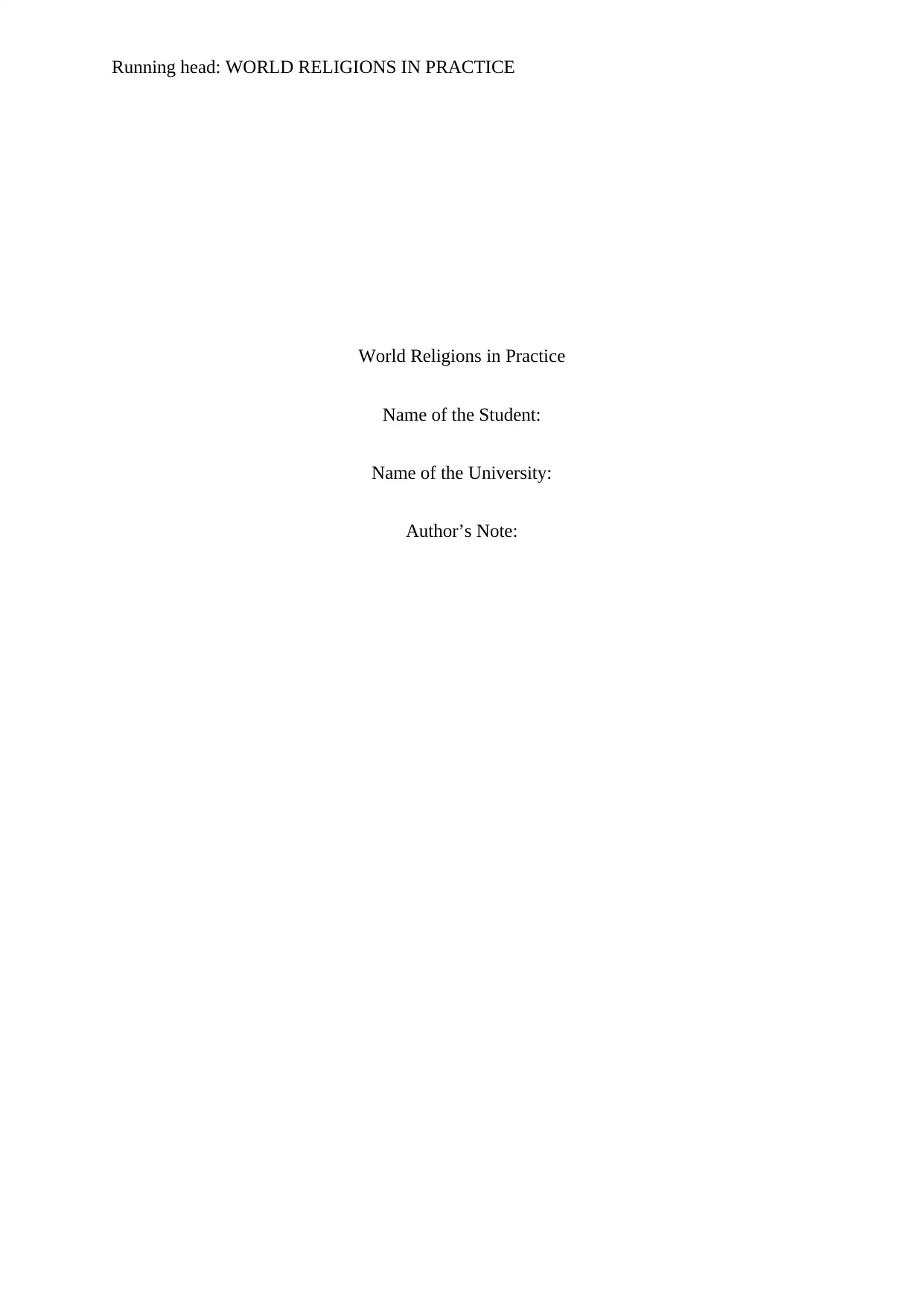
Running head: WORLD RELIGIONS IN PRACTICE
World Religions in Practice
Name of the Student:
Name of the University:
Author’s Note:
World Religions in Practice
Name of the Student:
Name of the University:
Author’s Note:
Secure Best Marks with AI Grader
Need help grading? Try our AI Grader for instant feedback on your assignments.
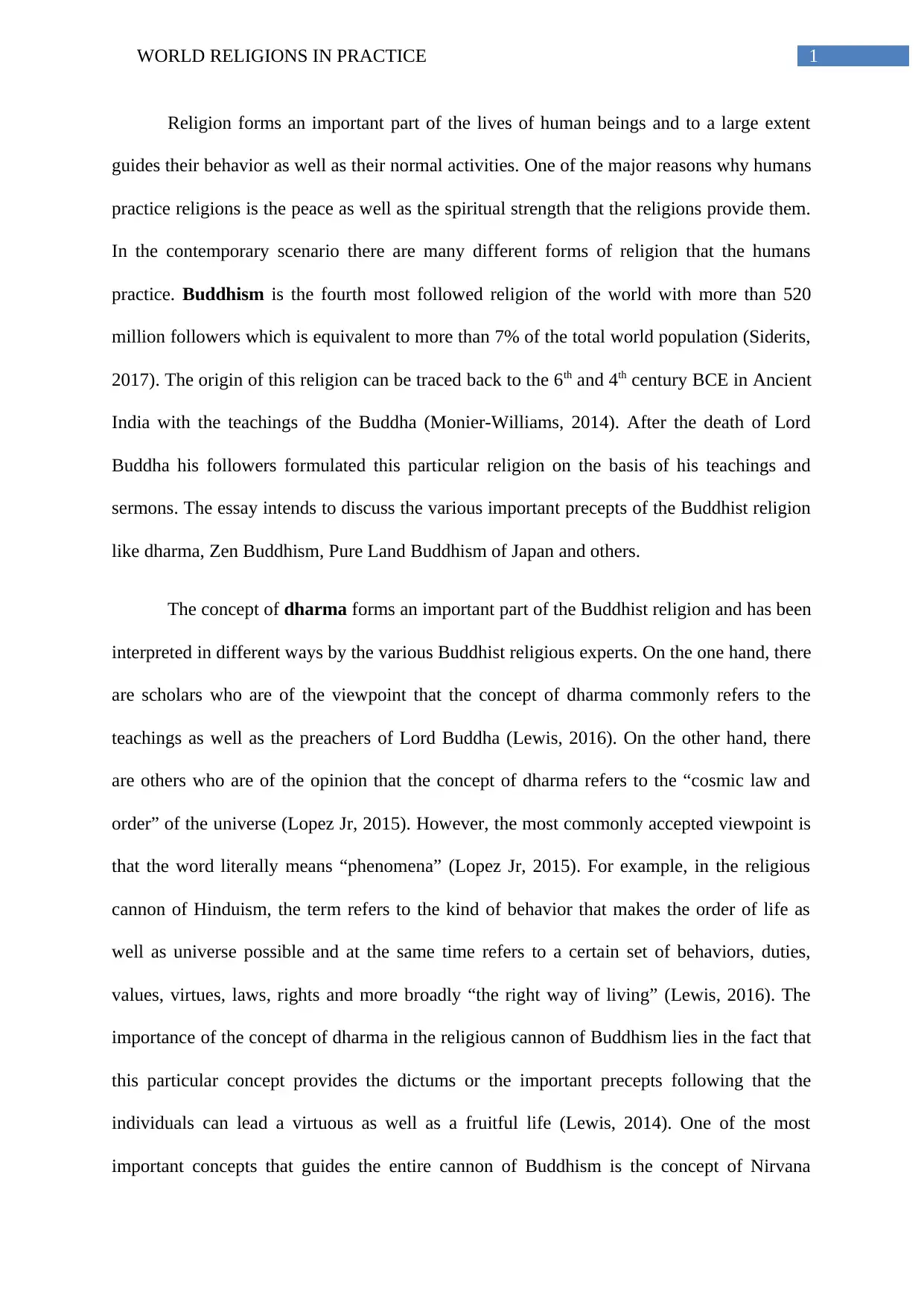
1WORLD RELIGIONS IN PRACTICE
Religion forms an important part of the lives of human beings and to a large extent
guides their behavior as well as their normal activities. One of the major reasons why humans
practice religions is the peace as well as the spiritual strength that the religions provide them.
In the contemporary scenario there are many different forms of religion that the humans
practice. Buddhism is the fourth most followed religion of the world with more than 520
million followers which is equivalent to more than 7% of the total world population (Siderits,
2017). The origin of this religion can be traced back to the 6th and 4th century BCE in Ancient
India with the teachings of the Buddha (Monier-Williams, 2014). After the death of Lord
Buddha his followers formulated this particular religion on the basis of his teachings and
sermons. The essay intends to discuss the various important precepts of the Buddhist religion
like dharma, Zen Buddhism, Pure Land Buddhism of Japan and others.
The concept of dharma forms an important part of the Buddhist religion and has been
interpreted in different ways by the various Buddhist religious experts. On the one hand, there
are scholars who are of the viewpoint that the concept of dharma commonly refers to the
teachings as well as the preachers of Lord Buddha (Lewis, 2016). On the other hand, there
are others who are of the opinion that the concept of dharma refers to the “cosmic law and
order” of the universe (Lopez Jr, 2015). However, the most commonly accepted viewpoint is
that the word literally means “phenomena” (Lopez Jr, 2015). For example, in the religious
cannon of Hinduism, the term refers to the kind of behavior that makes the order of life as
well as universe possible and at the same time refers to a certain set of behaviors, duties,
values, virtues, laws, rights and more broadly “the right way of living” (Lewis, 2016). The
importance of the concept of dharma in the religious cannon of Buddhism lies in the fact that
this particular concept provides the dictums or the important precepts following that the
individuals can lead a virtuous as well as a fruitful life (Lewis, 2014). One of the most
important concepts that guides the entire cannon of Buddhism is the concept of Nirvana
Religion forms an important part of the lives of human beings and to a large extent
guides their behavior as well as their normal activities. One of the major reasons why humans
practice religions is the peace as well as the spiritual strength that the religions provide them.
In the contemporary scenario there are many different forms of religion that the humans
practice. Buddhism is the fourth most followed religion of the world with more than 520
million followers which is equivalent to more than 7% of the total world population (Siderits,
2017). The origin of this religion can be traced back to the 6th and 4th century BCE in Ancient
India with the teachings of the Buddha (Monier-Williams, 2014). After the death of Lord
Buddha his followers formulated this particular religion on the basis of his teachings and
sermons. The essay intends to discuss the various important precepts of the Buddhist religion
like dharma, Zen Buddhism, Pure Land Buddhism of Japan and others.
The concept of dharma forms an important part of the Buddhist religion and has been
interpreted in different ways by the various Buddhist religious experts. On the one hand, there
are scholars who are of the viewpoint that the concept of dharma commonly refers to the
teachings as well as the preachers of Lord Buddha (Lewis, 2016). On the other hand, there
are others who are of the opinion that the concept of dharma refers to the “cosmic law and
order” of the universe (Lopez Jr, 2015). However, the most commonly accepted viewpoint is
that the word literally means “phenomena” (Lopez Jr, 2015). For example, in the religious
cannon of Hinduism, the term refers to the kind of behavior that makes the order of life as
well as universe possible and at the same time refers to a certain set of behaviors, duties,
values, virtues, laws, rights and more broadly “the right way of living” (Lewis, 2016). The
importance of the concept of dharma in the religious cannon of Buddhism lies in the fact that
this particular concept provides the dictums or the important precepts following that the
individuals can lead a virtuous as well as a fruitful life (Lewis, 2014). One of the most
important concepts that guides the entire cannon of Buddhism is the concept of Nirvana
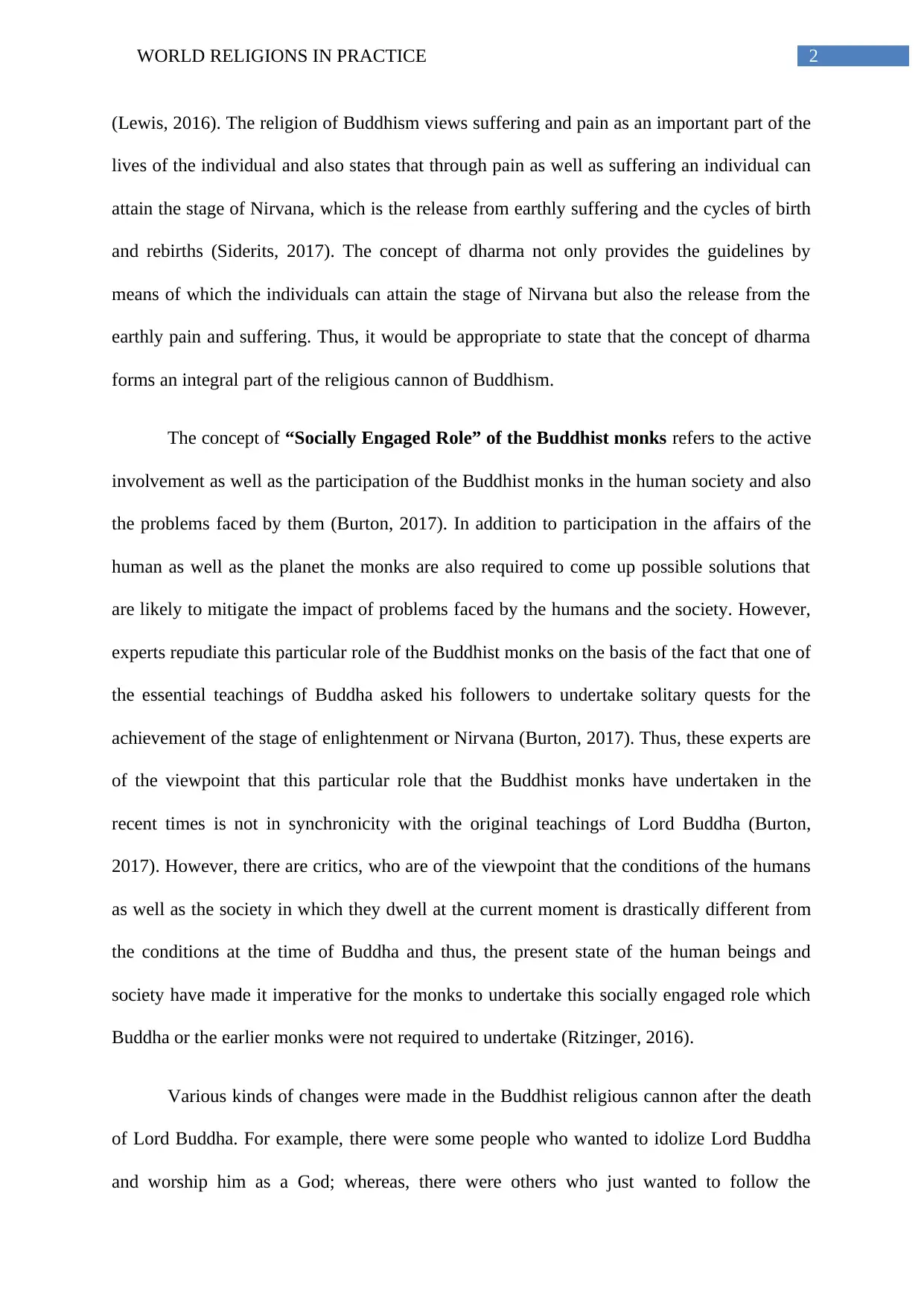
2WORLD RELIGIONS IN PRACTICE
(Lewis, 2016). The religion of Buddhism views suffering and pain as an important part of the
lives of the individual and also states that through pain as well as suffering an individual can
attain the stage of Nirvana, which is the release from earthly suffering and the cycles of birth
and rebirths (Siderits, 2017). The concept of dharma not only provides the guidelines by
means of which the individuals can attain the stage of Nirvana but also the release from the
earthly pain and suffering. Thus, it would be appropriate to state that the concept of dharma
forms an integral part of the religious cannon of Buddhism.
The concept of “Socially Engaged Role” of the Buddhist monks refers to the active
involvement as well as the participation of the Buddhist monks in the human society and also
the problems faced by them (Burton, 2017). In addition to participation in the affairs of the
human as well as the planet the monks are also required to come up possible solutions that
are likely to mitigate the impact of problems faced by the humans and the society. However,
experts repudiate this particular role of the Buddhist monks on the basis of the fact that one of
the essential teachings of Buddha asked his followers to undertake solitary quests for the
achievement of the stage of enlightenment or Nirvana (Burton, 2017). Thus, these experts are
of the viewpoint that this particular role that the Buddhist monks have undertaken in the
recent times is not in synchronicity with the original teachings of Lord Buddha (Burton,
2017). However, there are critics, who are of the viewpoint that the conditions of the humans
as well as the society in which they dwell at the current moment is drastically different from
the conditions at the time of Buddha and thus, the present state of the human beings and
society have made it imperative for the monks to undertake this socially engaged role which
Buddha or the earlier monks were not required to undertake (Ritzinger, 2016).
Various kinds of changes were made in the Buddhist religious cannon after the death
of Lord Buddha. For example, there were some people who wanted to idolize Lord Buddha
and worship him as a God; whereas, there were others who just wanted to follow the
(Lewis, 2016). The religion of Buddhism views suffering and pain as an important part of the
lives of the individual and also states that through pain as well as suffering an individual can
attain the stage of Nirvana, which is the release from earthly suffering and the cycles of birth
and rebirths (Siderits, 2017). The concept of dharma not only provides the guidelines by
means of which the individuals can attain the stage of Nirvana but also the release from the
earthly pain and suffering. Thus, it would be appropriate to state that the concept of dharma
forms an integral part of the religious cannon of Buddhism.
The concept of “Socially Engaged Role” of the Buddhist monks refers to the active
involvement as well as the participation of the Buddhist monks in the human society and also
the problems faced by them (Burton, 2017). In addition to participation in the affairs of the
human as well as the planet the monks are also required to come up possible solutions that
are likely to mitigate the impact of problems faced by the humans and the society. However,
experts repudiate this particular role of the Buddhist monks on the basis of the fact that one of
the essential teachings of Buddha asked his followers to undertake solitary quests for the
achievement of the stage of enlightenment or Nirvana (Burton, 2017). Thus, these experts are
of the viewpoint that this particular role that the Buddhist monks have undertaken in the
recent times is not in synchronicity with the original teachings of Lord Buddha (Burton,
2017). However, there are critics, who are of the viewpoint that the conditions of the humans
as well as the society in which they dwell at the current moment is drastically different from
the conditions at the time of Buddha and thus, the present state of the human beings and
society have made it imperative for the monks to undertake this socially engaged role which
Buddha or the earlier monks were not required to undertake (Ritzinger, 2016).
Various kinds of changes were made in the Buddhist religious cannon after the death
of Lord Buddha. For example, there were some people who wanted to idolize Lord Buddha
and worship him as a God; whereas, there were others who just wanted to follow the
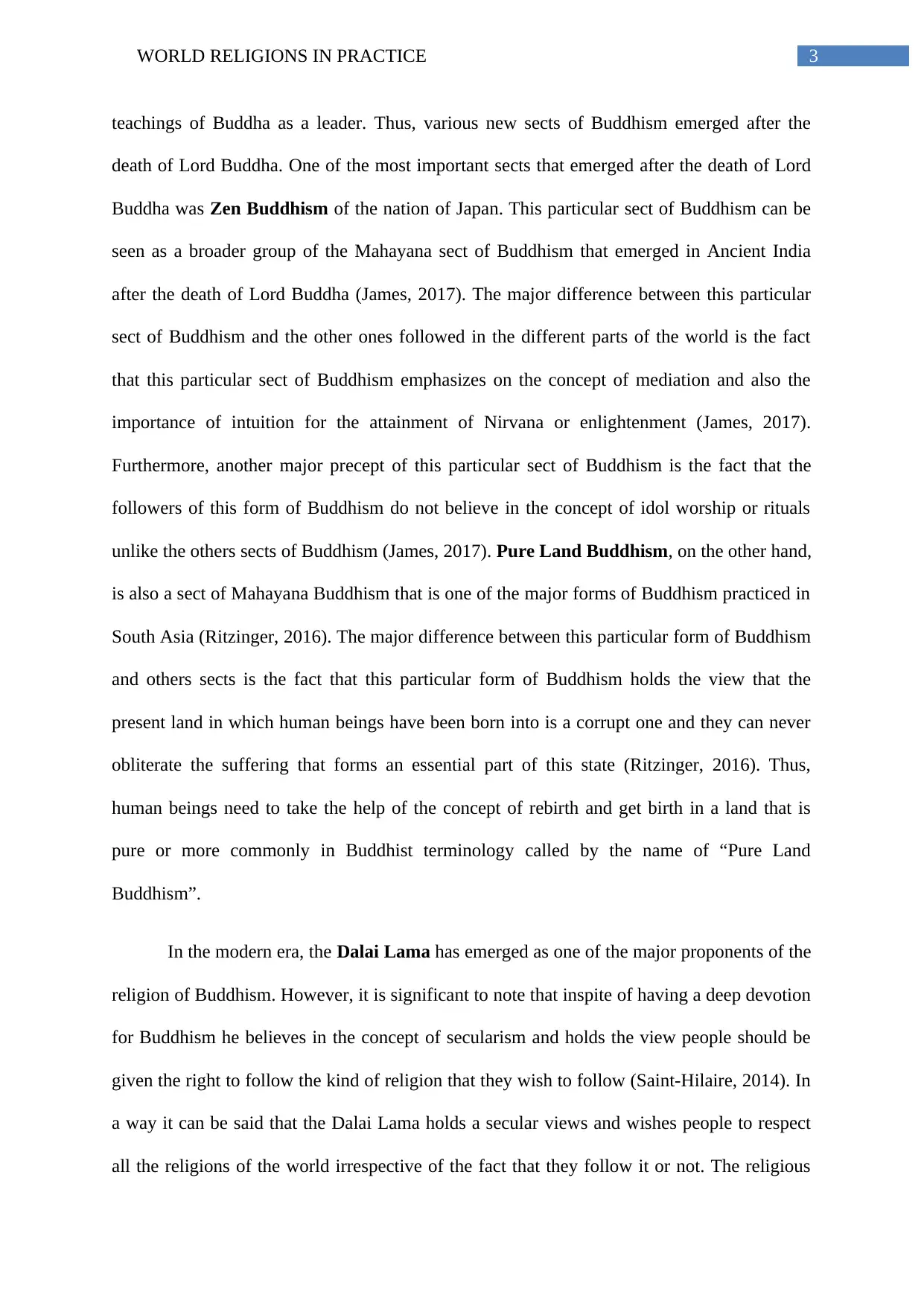
3WORLD RELIGIONS IN PRACTICE
teachings of Buddha as a leader. Thus, various new sects of Buddhism emerged after the
death of Lord Buddha. One of the most important sects that emerged after the death of Lord
Buddha was Zen Buddhism of the nation of Japan. This particular sect of Buddhism can be
seen as a broader group of the Mahayana sect of Buddhism that emerged in Ancient India
after the death of Lord Buddha (James, 2017). The major difference between this particular
sect of Buddhism and the other ones followed in the different parts of the world is the fact
that this particular sect of Buddhism emphasizes on the concept of mediation and also the
importance of intuition for the attainment of Nirvana or enlightenment (James, 2017).
Furthermore, another major precept of this particular sect of Buddhism is the fact that the
followers of this form of Buddhism do not believe in the concept of idol worship or rituals
unlike the others sects of Buddhism (James, 2017). Pure Land Buddhism, on the other hand,
is also a sect of Mahayana Buddhism that is one of the major forms of Buddhism practiced in
South Asia (Ritzinger, 2016). The major difference between this particular form of Buddhism
and others sects is the fact that this particular form of Buddhism holds the view that the
present land in which human beings have been born into is a corrupt one and they can never
obliterate the suffering that forms an essential part of this state (Ritzinger, 2016). Thus,
human beings need to take the help of the concept of rebirth and get birth in a land that is
pure or more commonly in Buddhist terminology called by the name of “Pure Land
Buddhism”.
In the modern era, the Dalai Lama has emerged as one of the major proponents of the
religion of Buddhism. However, it is significant to note that inspite of having a deep devotion
for Buddhism he believes in the concept of secularism and holds the view people should be
given the right to follow the kind of religion that they wish to follow (Saint-Hilaire, 2014). In
a way it can be said that the Dalai Lama holds a secular views and wishes people to respect
all the religions of the world irrespective of the fact that they follow it or not. The religious
teachings of Buddha as a leader. Thus, various new sects of Buddhism emerged after the
death of Lord Buddha. One of the most important sects that emerged after the death of Lord
Buddha was Zen Buddhism of the nation of Japan. This particular sect of Buddhism can be
seen as a broader group of the Mahayana sect of Buddhism that emerged in Ancient India
after the death of Lord Buddha (James, 2017). The major difference between this particular
sect of Buddhism and the other ones followed in the different parts of the world is the fact
that this particular sect of Buddhism emphasizes on the concept of mediation and also the
importance of intuition for the attainment of Nirvana or enlightenment (James, 2017).
Furthermore, another major precept of this particular sect of Buddhism is the fact that the
followers of this form of Buddhism do not believe in the concept of idol worship or rituals
unlike the others sects of Buddhism (James, 2017). Pure Land Buddhism, on the other hand,
is also a sect of Mahayana Buddhism that is one of the major forms of Buddhism practiced in
South Asia (Ritzinger, 2016). The major difference between this particular form of Buddhism
and others sects is the fact that this particular form of Buddhism holds the view that the
present land in which human beings have been born into is a corrupt one and they can never
obliterate the suffering that forms an essential part of this state (Ritzinger, 2016). Thus,
human beings need to take the help of the concept of rebirth and get birth in a land that is
pure or more commonly in Buddhist terminology called by the name of “Pure Land
Buddhism”.
In the modern era, the Dalai Lama has emerged as one of the major proponents of the
religion of Buddhism. However, it is significant to note that inspite of having a deep devotion
for Buddhism he believes in the concept of secularism and holds the view people should be
given the right to follow the kind of religion that they wish to follow (Saint-Hilaire, 2014). In
a way it can be said that the Dalai Lama holds a secular views and wishes people to respect
all the religions of the world irrespective of the fact that they follow it or not. The religious
Secure Best Marks with AI Grader
Need help grading? Try our AI Grader for instant feedback on your assignments.
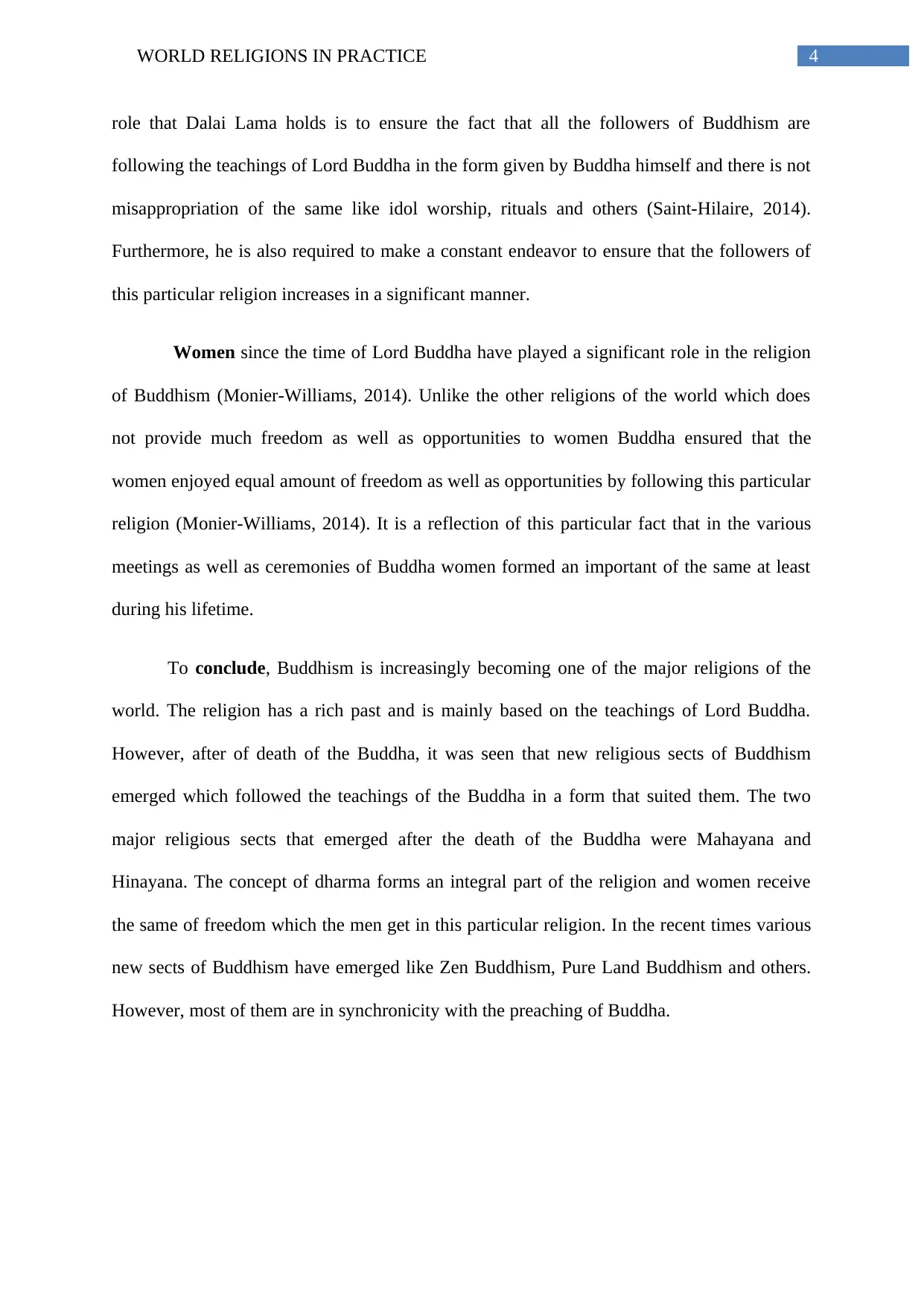
4WORLD RELIGIONS IN PRACTICE
role that Dalai Lama holds is to ensure the fact that all the followers of Buddhism are
following the teachings of Lord Buddha in the form given by Buddha himself and there is not
misappropriation of the same like idol worship, rituals and others (Saint-Hilaire, 2014).
Furthermore, he is also required to make a constant endeavor to ensure that the followers of
this particular religion increases in a significant manner.
Women since the time of Lord Buddha have played a significant role in the religion
of Buddhism (Monier-Williams, 2014). Unlike the other religions of the world which does
not provide much freedom as well as opportunities to women Buddha ensured that the
women enjoyed equal amount of freedom as well as opportunities by following this particular
religion (Monier-Williams, 2014). It is a reflection of this particular fact that in the various
meetings as well as ceremonies of Buddha women formed an important of the same at least
during his lifetime.
To conclude, Buddhism is increasingly becoming one of the major religions of the
world. The religion has a rich past and is mainly based on the teachings of Lord Buddha.
However, after of death of the Buddha, it was seen that new religious sects of Buddhism
emerged which followed the teachings of the Buddha in a form that suited them. The two
major religious sects that emerged after the death of the Buddha were Mahayana and
Hinayana. The concept of dharma forms an integral part of the religion and women receive
the same of freedom which the men get in this particular religion. In the recent times various
new sects of Buddhism have emerged like Zen Buddhism, Pure Land Buddhism and others.
However, most of them are in synchronicity with the preaching of Buddha.
role that Dalai Lama holds is to ensure the fact that all the followers of Buddhism are
following the teachings of Lord Buddha in the form given by Buddha himself and there is not
misappropriation of the same like idol worship, rituals and others (Saint-Hilaire, 2014).
Furthermore, he is also required to make a constant endeavor to ensure that the followers of
this particular religion increases in a significant manner.
Women since the time of Lord Buddha have played a significant role in the religion
of Buddhism (Monier-Williams, 2014). Unlike the other religions of the world which does
not provide much freedom as well as opportunities to women Buddha ensured that the
women enjoyed equal amount of freedom as well as opportunities by following this particular
religion (Monier-Williams, 2014). It is a reflection of this particular fact that in the various
meetings as well as ceremonies of Buddha women formed an important of the same at least
during his lifetime.
To conclude, Buddhism is increasingly becoming one of the major religions of the
world. The religion has a rich past and is mainly based on the teachings of Lord Buddha.
However, after of death of the Buddha, it was seen that new religious sects of Buddhism
emerged which followed the teachings of the Buddha in a form that suited them. The two
major religious sects that emerged after the death of the Buddha were Mahayana and
Hinayana. The concept of dharma forms an integral part of the religion and women receive
the same of freedom which the men get in this particular religion. In the recent times various
new sects of Buddhism have emerged like Zen Buddhism, Pure Land Buddhism and others.
However, most of them are in synchronicity with the preaching of Buddha.

5WORLD RELIGIONS IN PRACTICE
References
Burton, D. (2017). Buddhism, Knowledge and Liberation: A philosophical study.City:
London. Routledge.
James, S. P. (2017). Zen Buddhism and environmental ethics. City: London. Routledge.
Lewis, T. (Ed.). (2014). Buddhists: understanding Buddhism through the lives of
practitioners. UK. John Wiley & Sons.
Lewis, T. (Ed.). (2016). Teaching Buddhism: New Insights on Understanding and Presenting
the Traditions. City: London. Oxford University Press.
Lopez Jr, D. S. (2015). Buddhism in Practice: Abridged Edition. City: New Jersey. Princeton
University Press.
Monier-Williams, M. (2014). Buddhism, in its Connection with Brahmanism and Hinduism,
and in its Contrast with Christianity. New York: Macmillan And Co.
Ritzinger, J. R. (2016). Original Buddhism and its Discontents: the Chinese Buddhist
exchange monks and the search for the pure Dharma in Ceylon. Journal of Chinese
Religions, 44(2), 149-173.
Saint-Hilaire, J. B. (2014). The Buddha and His Religion (Routledge Revivals). City:
London. Routledge.
Siderits, M. (2017). Buddhism as philosophy: an introduction. City: London. Routledge.
References
Burton, D. (2017). Buddhism, Knowledge and Liberation: A philosophical study.City:
London. Routledge.
James, S. P. (2017). Zen Buddhism and environmental ethics. City: London. Routledge.
Lewis, T. (Ed.). (2014). Buddhists: understanding Buddhism through the lives of
practitioners. UK. John Wiley & Sons.
Lewis, T. (Ed.). (2016). Teaching Buddhism: New Insights on Understanding and Presenting
the Traditions. City: London. Oxford University Press.
Lopez Jr, D. S. (2015). Buddhism in Practice: Abridged Edition. City: New Jersey. Princeton
University Press.
Monier-Williams, M. (2014). Buddhism, in its Connection with Brahmanism and Hinduism,
and in its Contrast with Christianity. New York: Macmillan And Co.
Ritzinger, J. R. (2016). Original Buddhism and its Discontents: the Chinese Buddhist
exchange monks and the search for the pure Dharma in Ceylon. Journal of Chinese
Religions, 44(2), 149-173.
Saint-Hilaire, J. B. (2014). The Buddha and His Religion (Routledge Revivals). City:
London. Routledge.
Siderits, M. (2017). Buddhism as philosophy: an introduction. City: London. Routledge.
1 out of 6
Related Documents
Your All-in-One AI-Powered Toolkit for Academic Success.
+13062052269
info@desklib.com
Available 24*7 on WhatsApp / Email
![[object Object]](/_next/static/media/star-bottom.7253800d.svg)
Unlock your academic potential
© 2024 | Zucol Services PVT LTD | All rights reserved.





